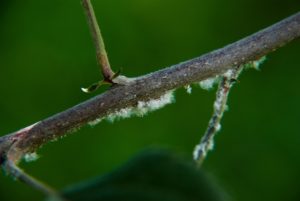WNC Orchard Insect Populations for June 12, 2018
go.ncsu.edu/readext?532149
en Español / em Português
El inglés es el idioma de control de esta página. En la medida en que haya algún conflicto entre la traducción al inglés y la traducción, el inglés prevalece.
Al hacer clic en el enlace de traducción se activa un servicio de traducción gratuito para convertir la página al español. Al igual que con cualquier traducción por Internet, la conversión no es sensible al contexto y puede que no traduzca el texto en su significado original. NC State Extension no garantiza la exactitud del texto traducido. Por favor, tenga en cuenta que algunas aplicaciones y/o servicios pueden no funcionar como se espera cuando se traducen.
Português
Inglês é o idioma de controle desta página. Na medida que haja algum conflito entre o texto original em Inglês e a tradução, o Inglês prevalece.
Ao clicar no link de tradução, um serviço gratuito de tradução será ativado para converter a página para o Português. Como em qualquer tradução pela internet, a conversão não é sensivel ao contexto e pode não ocorrer a tradução para o significado orginal. O serviço de Extensão da Carolina do Norte (NC State Extension) não garante a exatidão do texto traduzido. Por favor, observe que algumas funções ou serviços podem não funcionar como esperado após a tradução.
English
English is the controlling language of this page. To the extent there is any conflict between the English text and the translation, English controls.
Clicking on the translation link activates a free translation service to convert the page to Spanish. As with any Internet translation, the conversion is not context-sensitive and may not translate the text to its original meaning. NC State Extension does not guarantee the accuracy of the translated text. Please note that some applications and/or services may not function as expected when translated.
Collapse ▲ June 12, 2018
June 12, 2018
First generation codling moth flight has subsided in both the mountains and piedmont locations. The only location where codling moth remains a threat, and where insecticidal control should continue, is where populations are historically high. This includes orchards adjacent to poorly managed orchards or where wooden apple bins (originating from other states) are stored.
We are in the midst of second-generation OFM flight, but as mentioned last week, this generation is usually of little threat where the first generation was adequately controlled. Based on recent observations in commercial orchards, there is very little if any damage by first-generation codling moth or OFM.
If an insecticide effective against TABM, such as Altacor (or Voliam Flexi), Delegate or Intrepid, has not been applied within the last two weeks, an application should be made within the next week.
Finally, we’re approaching that time of the year when apple aphids and potato leafhopper populations are beginning to appear. Both insects prefer to feed on new shoot growth. Now is a good time to scout orchards to determine the need for control. They are easily controlled with a range of neonicotinoids or closely related compounds, such as Admire, Assail, Actara, Closer, or Sivanto.
Learn more about southeastern apple insect pests at the Apple Insect Management page.
2018 Average Weekly Trap Captures*
| HENDERSON COUNTY | |||
| Insects per trap | |||
| May 29 |
June 4 |
June 11 |
|
| Codling Moth | 3.5 | 0.3 | 0.8 |
| Oriental Fruit Moth | 5.7 | 13.0 | 16.0 |
| Tufted Apple Bud Moth | 12.0 | 11.0 | 1.0 |
| Redbanded Leafroller | 0.0 | 0.0 | 0.0 |
| Obliquebanded Leafroller | 1.0 | 2.0 | 0.0 |
| Lesser Appleworm | 0.0 | 1.0 | 0.0 |
| Apple Maggot | 0.0 | 0.0 | 0.0 |
| Brown Marmorated Stink Bug (commercial – mountains) | 1.3 | 1.7 | 1.5 |
| Brown Marmorated Stink Bug (commercial – upper piedmont) | 3.7 | 2.0 | 0.7 |
| Brown Marmorated Stink Bug (research – unsprayed) | 0.3 | 2.0 | 2.5 |
| Spotted Tentiform Leafminer | 0.0 | 0.0 | 40.0 |
| Dogwood Borer | 31.0 | 18.0 | 18.0 |
| Peachtree Borer | 1.5 | 7.5 | 16.0 |
| Lesser Peachtree Borer | 25.0 | 20.5 | 42.5 |
| San Jose Scale | 0.0 | 0.0 | 7.5 |
*Note that averages presented here are intended only to illustrate the timing of insect emergence and fluctuations in population activity, and not as general indicators of population levels. Some orchards included in these averages have significantly higher or lower populations than most commercial orchards in the area, resulting in averages that are sometimes skewed from what is typical. The only way to have an accurate assessment of an individual orchard’s populations is to set up traps in that orchard.
2018 Accumulated Degree Days
| Henderson County | ||||
| Biofix | May 29 |
June 5 |
June 11 |
|
| Codling Moth | Apr 30 | 501 | 654 | 797 |
| Oriental Fruit Moth | Apr 2 | 883 | 1071 | 1249 |
| Tufted Apple Bud Moth | May 4 | 564 | 752 | 929 |
| About degree-day models: The degree day (DD) models predict adult emergence and egg hatch of each generation. They do not predict the intensity of populations, which can be assessed by using pheromone traps. Hence, the models should be used to help gauge the time period when control is most likely needed, and pheromone traps provide information on the need for and frequency of insecticide applications. For full details, read “IPM Practices for Selected Pests” in the Orchard Management Guide. |
CODLING MOTH:
|
ORIENTAL FRUIT MOTH:
|
TUFTED APPLE BUD MOTH:
|


